 |
|
|
| (Information by Peter Kessler, with additional information by Edward Dawson, from The Landscape of King Arthur, Geoffrey Ashe, from The Four Branches of the Mabinogi, Will Parker, from Welsh Genealogies AD 300-1400, Peter Bartrum, from A History of Wales, John Davies, 1994, from Wales and the Britons, 350-1064, T M Charles-Edwards (Oxford University Press, 2013), from History of the Kings of Britain, Geoffrey of Monmouth, from A History of the English Church and People, The Venerable Bede (Leo Sherley-Price translation - revised by R E Latham), from The Oxford History of England: Roman Britain, Peter Salway, from Atlas of British History, G S P Freeman-Grenville (Rex Collins, London, 1979), from Etymological Glossary of Old Welsh, Alexander Falileyev, and from External Link: Ancient Welsh Studies.) |
|
|
| 382 - ? |
Antonius Donatus Gregorius / Anwn Dynod |
'King of South Wales'. Son of Magnus Maximus. |
| 382 |
 Antonius Donatus Gregorius, son of Magnus Maximus (at least, according to later claims, and see feature link for more), is placed in command of the southern section of late [ Roman](../KingListsEurope/ItalyRomeEmpire.htm#Flavians Secundas) Britain's westernmost coast, in what is the equivalent to the later South Wales region. This is claimed as being part of the reorganisations of Magnus Maximus prior to his expedition into Gaul to claim the imperial title. Antonius Donatus Gregorius, son of Magnus Maximus (at least, according to later claims, and see feature link for more), is placed in command of the southern section of late [ Roman](../KingListsEurope/ItalyRomeEmpire.htm#Flavians Secundas) Britain's westernmost coast, in what is the equivalent to the later South Wales region. This is claimed as being part of the reorganisations of Magnus Maximus prior to his expedition into Gaul to claim the imperial title. 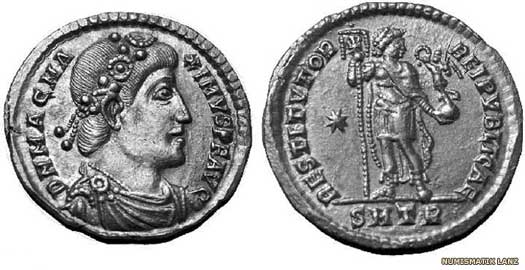 The reverse of this coin which was issued by Magnus Maximus during his reign as co-emperor shows him standing, holding a laburnum and Victory on a globe The reverse of this coin which was issued by Magnus Maximus during his reign as co-emperor shows him standing, holding a laburnum and Victory on a globe |
|
| It also seems to be Magnus Maximus who settles a sept of the Irish Déisi in Demetia. The act would fit in with a general policy of this period of shoring up Britain's defences by moving entire groups of people to defend the weaker areas - most notably a group of Romanised Venicones to Venedotia. Aed Brosc seems to be the Déisi leader who is contacted and invited to settle in Demetia (probably in the period between 380-383, although they may already be present from about AD 300). |
|
|
| fl 382 |
Aed Brosc / Ewein Vreisg |
Historical leader of the Déisi in Demetia. |
| 388 |
Upon the death of Magnus Maximus, Antonius appears to be accepted by the Demetae inhabitants of his territory. He retains control of the region, which means that he is also successful in driving off the Irish raiders who have been threatening the coast. Mentioned as a king by later traditional sources, he more probably holds the rank of decurion (also mentioned by some scholars) or a magistrate who is based at Maridunum (Carmarthen). 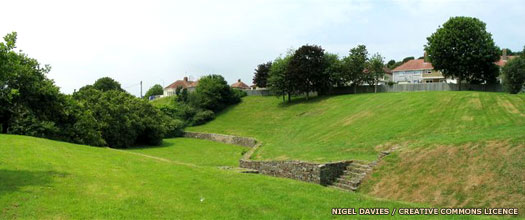 Carmarthen's Roman amphitheatre would still have been largely intact in this period, if perhaps rather scruffy, and the town walls remained standing (in part) as late as the time of Giraldus Cambrensis (twelfth century) Carmarthen's Roman amphitheatre would still have been largely intact in this period, if perhaps rather scruffy, and the town walls remained standing (in part) as late as the time of Giraldus Cambrensis (twelfth century) |
|
 He and his successors have been given Welsh names by later chroniclers (Anwn Dynod in his case, 'Anwn' from 'Antonius' and 'Dynod' from 'Donatus'), but it is much more likely that during their own lifetimes they bear Latinised names and conduct themselves as [ Romans](../KingListsEurope/ItalyRomeEmpire.htm#Flavians Secundas). Some elements of the life of Antonius may later be incorporated into the Arthurian stories (see feature link). He and his successors have been given Welsh names by later chroniclers (Anwn Dynod in his case, 'Anwn' from 'Antonius' and 'Dynod' from 'Donatus'), but it is much more likely that during their own lifetimes they bear Latinised names and conduct themselves as [ Romans](../KingListsEurope/ItalyRomeEmpire.htm#Flavians Secundas). Some elements of the life of Antonius may later be incorporated into the Arthurian stories (see feature link). |
|
|
| fl c.400 |
Demetius / Ednyfed ap Anwn |
Son of Antonius. Established a kingship. |
Demetrius, son of Antonius, is also accepted by the Demetae as their first hereditary king of the late Roman period. This is probably not a difficult prospect as Magnus Maximus, his grandfather, is held in such high esteem by the people of western Britain that he is remembered as a founding figure of much of later Wales (which may also be a reflection of his influence - and even his original military rank and posting - in what is to become Wales). According to later tradition, Demetius - under the Welsh form of his name: Ednyfed ap Awn - has at least two sons, Gloitguin (or Gloitgwyn) and Dyfnwal. The name of the former seems at first sight to be the Welsh form of a Latinised name, but there is some difficulty in accepting him because the next ruler of Demetia, Clotrius, is claimed as being the son of Demetrius. 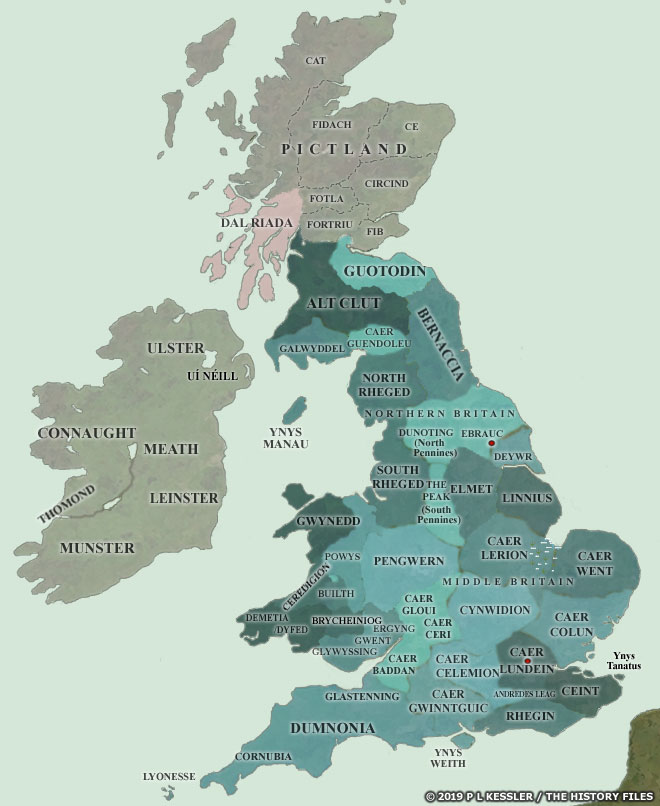 This map of Britain concentrates on British territories and kingdoms which were established during the fourth and fifth centuries AD, as the Saxons and Angles began their settlement of the east coast (click or tap on map to view full sized) This map of Britain concentrates on British territories and kingdoms which were established during the fourth and fifth centuries AD, as the Saxons and Angles began their settlement of the east coast (click or tap on map to view full sized) |
|
|
Gloitguin is also referred to as the father of Clotrius, so perhaps Gloitguin dies before he is able to govern Demetia himself and is therefore forgotten by some later chroniclers. However, 'Gloitguin' looks like a nickname which means 'blue-white', and also looks suspiciously similar to the base element of the name of Caer Gloui. Is it a pun? As for Dyfnwal, he may govern a sub-unit of Demetia (a pagus), and may be the father of the Honorius (Ynyr Gwent) who marries St Madrun, daughter of Vortimer (Gwerthefyr), the ruler or magistrate of Gwent. Again though, the name seems suspicious. The first element of Dyfnwal is 'dyfn' (modernised as 'Devon'), which is how the kingdom of Dumnonia comes to be known. The second element, 'wal', means 'wealas', which is a term frequently used by Angles and Saxons to denote the presence of Britons (Welsh), in this case the Britons of Devon. Even the name Demetius is suspect here, being suspiciously close to 'Demetia'. All three have to be treated with great care as they all seem to be created by using the names of places to form identities. 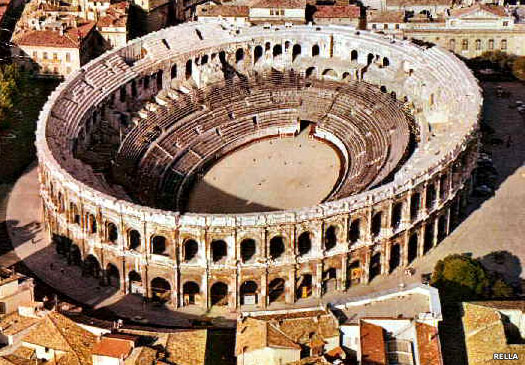 Times were tough in the mid-fifth century, and Britain's resources were not what they had once been, what with barbarians at the door and withdrawal from the fading Roman empire, so Caer Gloui's amphitheatre had to be made defendable (Nemausus (Nimes) amphitheatre is shown here as an example) Times were tough in the mid-fifth century, and Britain's resources were not what they had once been, what with barbarians at the door and withdrawal from the fading Roman empire, so Caer Gloui's amphitheatre had to be made defendable (Nemausus (Nimes) amphitheatre is shown here as an example) |
|
|
| fl c.405 |
Urb mac Aed |
Son of Aed Brosc. Took Déisi into Brycheiniog region. |
| fl c.410 - c.421 |
Clotrius / Clotri ap Ednyfed |
Son (or grandson) of Demetius. Last British ruler of Demetia. |
| fl c.410s? |
Maelgwn |
Son and heir, but predeceased his father. |
| c.420 |
Anlach, grandson of Urb mac Aed, marries Marchel, whom later Welsh works describe as the 'heiress of Garthmadrun'. The same works give Anlach's father as Cornac or Coronac, who is generally linked to Cormac mac Urb of the Déisi. Given the calculation that the Déisi had arrived in Demetia around AD 300, this would give them ample time to become integrated into the regional nobility and for their leading sons to marry the offspring of the surviving Brito-Welsh nobility, hence Anlach's marriage to Marchel. Upon Anlach's death, the Garthmadrun territory becomes Brycheiniog. |
|
| c.421 |
With the only male heir of Clotrius now dead, his daughter Gweldyr is the sole heiress to the kingdom (but see the fascinating argument by the Ancient Welsh Studies website which suggests that Clotrius 'himself' is actually a daughter of Demetius rather than a son). 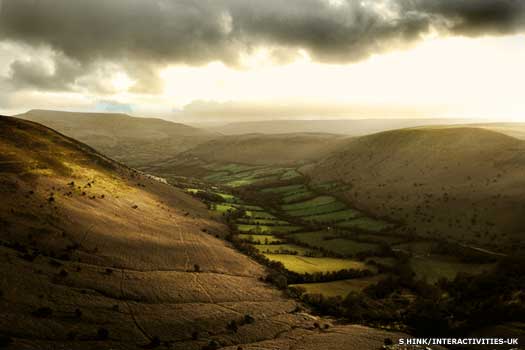 The fluctuating fortunes of the principality of Brycheiniog took place in the dramatic landscape of the Brecon Beacons in south-eastern Wales The fluctuating fortunes of the principality of Brycheiniog took place in the dramatic landscape of the Brecon Beacons in south-eastern Wales |
|
| Although Gweldyr may be considerably younger, she marries Triphun of the Romanised Déisi who have long been settled in western Britain. He inherits leadership of Demetia, while that name, 'Demetia', is retained but is altered in its Irish pronunciation so that, within about a century, the accepted pronunciation is 'Dyfed'. |
|
|
|
|
|
Dyfed (of the Déisi) / Rheinwg (Wales)  The expulsion of Roman officials in AD 409 (see feature link), meant that Post-Roman Britain struggled on without support from continental Europe. It faced plague, mercenary revolt, civil war, and a general break-down in trade, communications, and unity. Over the course of about three centuries the Britons gradually lost the entire west and centre of the island to Germanic invaders. In the west, largely in what would become modern Wales, the end of national unity seems to have started earlier and taken place more quickly. Several territories emerged here, with later tradition claiming the creation of the 'kingdoms' of 'North Wales', 'South Wales', and 'Mid-South Wales'. North Wales became Gwynedd, while South Wales became Dyfed, and these two states, along with Powys, formed the largest principalities in the surviving western British territories. They never in reality used the English term, 'kingdom'. The South Wales territory eventually became better known as Demetia - or it was known as this from the beginning. 'South Wales' was a later label for it anyway. It was a Romanised territory which offered a degree of continuation from the pre-Roman Demetae control of the region. The Déisi tribe of the County Waterford region in Ireland were apparently settled by the existing Roman authorities in the region of Demetia by AD 382, although this may well have been a defensive organisation of a group which had already infiltrated and settled the region. Their leader at the time, Aed Brosc, was one of his people's key figures. His grandfather, Eochaid Allmuir, had been forced to leave his homeland after a bid for independence failed. The descendants of Aed Brosc's eldest son, Urb, founded the kingdom of Brycheiniog between 420-450, while his younger son, Triffyn Farfog, married the heiress of the British Demetian rulers. Like most Irish royalty, Eochaid claimed descent from Beli Mawr, the Celtic sun god who was also claimed as a second century BC high king of pre-Roman Prydein, through his son, Miled. Another branch of the expelled Déisi became the Dál gCais clan of Thomond. The name Dyfed (also known as Dyfor) seems to have been the Déisi pronunciation of the older name of Demetia. The early Déisi settlers were very receptive to the benefits of the Roman way of life, and they gave their children Romano-British names. These were recorded by the early Welsh in Welsh format, and later rulers became completely Welsh in background as Roman influence faded. The Déisi rulers initially used the Roman title of 'protector' (protictoris) instead of the Latin 'magistrate' or princeps. This practice continued at least as far as Vortipor, whose memorial stone was discovered at Castell Dwyran. The expulsion of Roman officials in AD 409 (see feature link), meant that Post-Roman Britain struggled on without support from continental Europe. It faced plague, mercenary revolt, civil war, and a general break-down in trade, communications, and unity. Over the course of about three centuries the Britons gradually lost the entire west and centre of the island to Germanic invaders. In the west, largely in what would become modern Wales, the end of national unity seems to have started earlier and taken place more quickly. Several territories emerged here, with later tradition claiming the creation of the 'kingdoms' of 'North Wales', 'South Wales', and 'Mid-South Wales'. North Wales became Gwynedd, while South Wales became Dyfed, and these two states, along with Powys, formed the largest principalities in the surviving western British territories. They never in reality used the English term, 'kingdom'. The South Wales territory eventually became better known as Demetia - or it was known as this from the beginning. 'South Wales' was a later label for it anyway. It was a Romanised territory which offered a degree of continuation from the pre-Roman Demetae control of the region. The Déisi tribe of the County Waterford region in Ireland were apparently settled by the existing Roman authorities in the region of Demetia by AD 382, although this may well have been a defensive organisation of a group which had already infiltrated and settled the region. Their leader at the time, Aed Brosc, was one of his people's key figures. His grandfather, Eochaid Allmuir, had been forced to leave his homeland after a bid for independence failed. The descendants of Aed Brosc's eldest son, Urb, founded the kingdom of Brycheiniog between 420-450, while his younger son, Triffyn Farfog, married the heiress of the British Demetian rulers. Like most Irish royalty, Eochaid claimed descent from Beli Mawr, the Celtic sun god who was also claimed as a second century BC high king of pre-Roman Prydein, through his son, Miled. Another branch of the expelled Déisi became the Dál gCais clan of Thomond. The name Dyfed (also known as Dyfor) seems to have been the Déisi pronunciation of the older name of Demetia. The early Déisi settlers were very receptive to the benefits of the Roman way of life, and they gave their children Romano-British names. These were recorded by the early Welsh in Welsh format, and later rulers became completely Welsh in background as Roman influence faded. The Déisi rulers initially used the Roman title of 'protector' (protictoris) instead of the Latin 'magistrate' or princeps. This practice continued at least as far as Vortipor, whose memorial stone was discovered at Castell Dwyran. |
|
|
 |
|
|
| (Information by Peter Kessler, with additional information by Edward Dawson, from The Landscape of King Arthur, Geoffrey Ashe, from The Four Branches of the Mabinogi, Will Parker, from Welsh Genealogies AD 300-1400, Peter Bartrum, from A History of Wales, John Davies, 1994, from Welsh Medieval Law, Arthur Wade-Evans, 1909, and from the Historia Brittonum (The History of the Britons), Nennius, and De Excidio Brittaniae et Conquestu (On the Ruin of Britain), Gildas (both J A Giles, Ed & Trans, 1841, published as part of Six Old English Chronicles (Henry G Bohn, London, 1848)).) |
|
|
| fl c.421 - c.445 |
Valerian / Triphun mac Aed |
Brother of Urb. m Gweldyr of Demetia. First Irish prince. |
The name Triphun is an Irish version of the Latin 'tribune'. Also shown as Trestin, this is clearly a rank rather than a name. His name seems to be Valerian, making him Tribune Valerian, a Romanised Irish king. 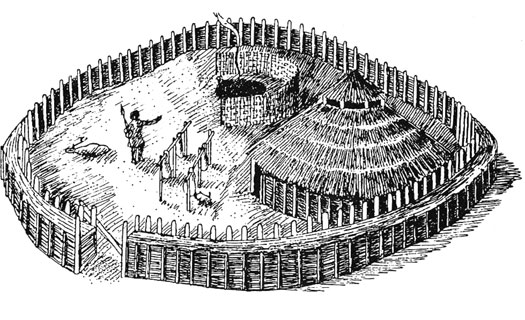 This is a reconstruction of a typical Irish dwelling in the Bronze Age, at Cullyhanna in County Armagh, and it is probably safe to assume that the Irish in Demetia initially produced dwellings which were similar This is a reconstruction of a typical Irish dwelling in the Bronze Age, at Cullyhanna in County Armagh, and it is probably safe to assume that the Irish in Demetia initially produced dwellings which were similar |
|
|
| As what is likely to be the fourth generation of Déisi to have been raised in Britain, the tribe now has roots in the country and has clearly developed a certain degree of reliability and trustworthiness. By taking a Roman name, Valerian has become part of the British ruling elite, so much so that he is able to marry Gweldyr, the Romano-British heiress of Demetia. In later Welsh works he is Triffyn Farfog ('the Bearded'). |
|
|
| c.432 - 436 |
Aurelius Ambrosius of Caer Gloui is apparently a leader of a British council, which presumably answers to Vortigern. It is his decision to confirm the Irish Déisi as commanders of the Demetia area of the west coast in order to counter the threat posed by Irish raiders. Vortigern acquiesces and assigns to Ambrosius 'Dinas Emrys and all the western lands', suggesting that Ambrosius becomes the architect for the defence of these western areas. This is motivated by the council's reluctance to depend entirely upon Saxon mercenaries, with their constant demands for increased provisions, especially in an area in which they would be lightly supervised. The Déisi have already been settled for some time and are clearly self-supporting. |
|
| c.440s/450s |
There is a probable Irish presence at Dunster Castle (Dindraithov or Dindraethou to the Welsh) in the early post-Roman period. This is a fort which overlooks the approaches to Exmoor, four and-a-half kilometres to the south-east of Minehead in Somerset (roughly on the edges of Dumnonian territory). 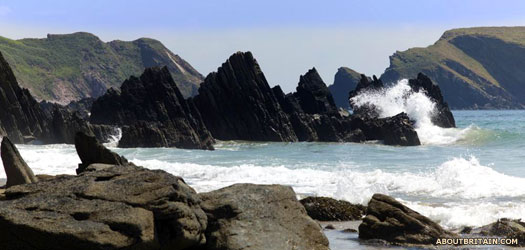 The coast of Pembrokeshire, part of the territory of the Demetae and the later kingdom of Dyfed, is a mixture of sandy beaches and daunting rocks (as at Marloes Sands, shown here), but there would have been many places for the Déisi to land and seize some territory The coast of Pembrokeshire, part of the territory of the Demetae and the later kingdom of Dyfed, is a mixture of sandy beaches and daunting rocks (as at Marloes Sands, shown here), but there would have been many places for the Déisi to land and seize some territory |
|
The modern castle may not be the same site as the post-Roman fort, which could be located a little way inland. Irish settlers are frequenting Somerset at this time, which suggests that they are people who have already been accepted into Britain, such as are the Déisi of Dyfed.  They are not large in number but they do remain for a long time. Nearby Glastonbury is spoken of as 'Glastonbury of the Gaels' thanks to its shrines of St Patrick and St Brigit. The fort at Dunster features in the list of twenty-eight cities of Britain in Nennius' Historia Brittonum, appearing as Caer Draithou (see feature link), and is also mentioned in the Life of St Carannog (of Ceredigion). They are not large in number but they do remain for a long time. Nearby Glastonbury is spoken of as 'Glastonbury of the Gaels' thanks to its shrines of St Patrick and St Brigit. The fort at Dunster features in the list of twenty-eight cities of Britain in Nennius' Historia Brittonum, appearing as Caer Draithou (see feature link), and is also mentioned in the Life of St Carannog (of Ceredigion). |
|
|
| fl c.467 |
Agricola / Aircol / Aergol |
Son. Aricol Lawhir 'Long-Hand' mac Triffyn. |
Agricola bears another Romanised name, just like his father, showing that the Déisi kings of Dyfed have become fully-fledged members of Romano-British society. Later variations of his name include the fully Welsh Aricol Lawhir, the appellation meaning 'long-hand'. He holds court at Lis Castell (Lydstep) near Din Bych (Tenby). He is also reputed to be a British Church patron, both of the church at Llandaff and of St Euddogwy and St Teilo, the bishops of Glywyssing. Euddogwy is the son of Budic II, high king of the Bretons of Vannetais, whom Agricola takes in after he is expelled from his lands. 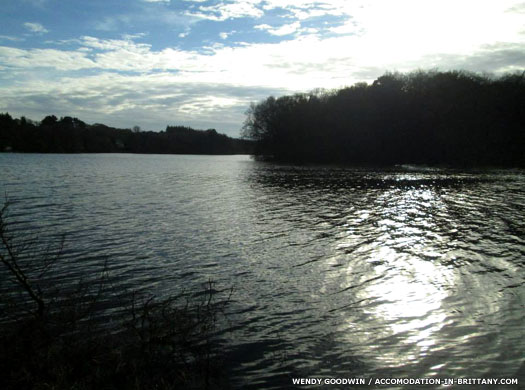 The landscape of Armorica - extremely hilly inland with a wonderful, long coastline - would have seemed very familiar to the Britons who began to settle here from the late fourth century onwards (Glomel in the modern Côtes-d'Armor département is shown here) The landscape of Armorica - extremely hilly inland with a wonderful, long coastline - would have seemed very familiar to the Britons who began to settle here from the late fourth century onwards (Glomel in the modern Côtes-d'Armor département is shown here) |
|
|
| fl c.460s/480s |
Cunoricus / Cynyr Ceinfarfog |
Lord of Cantref Pebidiog. Sir Ector in Arthurian legend. |
| late 400s |
The minor vassal state of Caer Goch (or Caer Gawch - seemingly a later form of the name) emerges within the territory of Dyfed. It is held by Cynyr Ceinfarfog (the Welsh form of the name which probably dates to the eighth century or later), otherwise known as Cunoricus. This is Latin form of the name, one which is much more likely to be the version used by the man himself - the modern form is Kendrick. However, 'Cynyr' can be traced back to the Irish name Connor, which is also used in the formation of the name Conchobhar (meaning 'lover of hounds'). The likeliest explanation is that Cynyr is Déisi Irish, and that he adapts his name so that it becomes familiar to Romano-British ears. In Welsh a 'y' can be pronounced in two ways, either as the English 'y' or as a 'u'. In this case it would be a 'u', so that Irish Conner becomes early Welsh 'cunur'. The transition to Cunoricus as a Latinised Connor/Conchobhar is more difficult to accept, thanks to the '-ic' in the middle, although it is still possible. The appellation of 'ceinfarfog' means 'fair bearded', possibly referring to a blonde beard but equally possibly to a black beard, as the Celts (and their modern Welsh descendants) have a well-developed sense of humour when it comes to names. 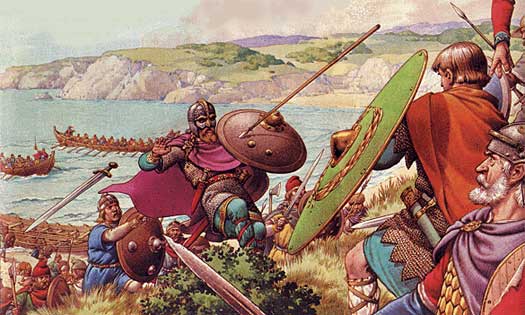 The coming of Ælle in AD 477 and his apparently pre-established status as bretwalda spelled eventual defeat and death for the Britons of modern Sussex, and quite possibly led to the siege of Mons Badonicus around the end of the century The coming of Ælle in AD 477 and his apparently pre-established status as bretwalda spelled eventual defeat and death for the Britons of modern Sussex, and quite possibly led to the siege of Mons Badonicus around the end of the century |
|
| Cunoricus governs the cantref of Pebidiog from Castell-Coch (Caer Gawch, although there are three places with this name, this one being near Mynyw, close to St Davids). Caer-Gynyr (later known as Caer Cai) near Bala in Penllyn is also claimed as being his - which creates an interesting scenario. By the end of the fifth century Penllyn is apparently part of the sub-kingdom of Rhos, itself a division of Venedotia. However, it seems unlikely that its first ruler is in place before AD 480, which raises the interesting prospect of Cunoricus being a Romano-British warlord or official who is replaced or succeeded by the newcomers who now rule in North Wales. It is certainly a sign of the times on Britain's western coastline. Cunoricus is also the Sir Ector of Arthurian legend, who raises the young Arthur as his foster son prior to the latter becoming high king. |
|
|
| fl c.495 - 540 |
Vortipor / Vortiporious / Voteporix |
Son of Agricola. 'Protector' of Dyfed. British leader. |
| c.540 |
Vortipor is clearly a powerful figure in British history, as noted by his being included in the list of high kings of Britain. Vortipor's name has been recorded in various ways, from the Latinised Vortipor itself, to the Gaulish Voteporix, and the (perhaps) more genuinely original Vortepor mac Aricol. Even this has been recorded as Gartbuir mac Alchoil (in The Expulsion of the Déisi, written in the eighth century), and Guortepir (from an eleventh century pedigree). 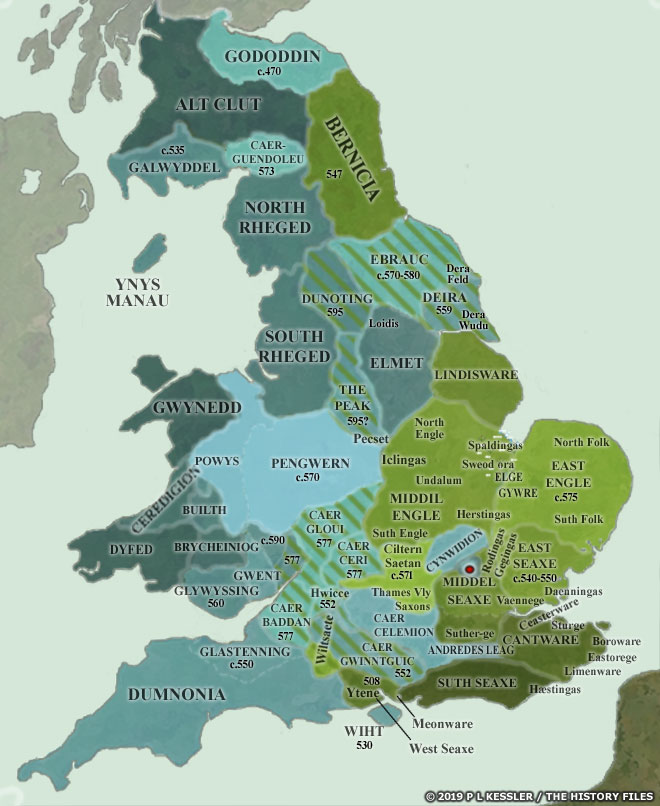 At the start of this period, the Angle and Saxon kingdoms on the east and south coasts were firmly established. Many of the rapidly-formed Romano-British territories in those areas had been swept away in the late fifth century (click or tap on map to view full sized) At the start of this period, the Angle and Saxon kingdoms on the east and south coasts were firmly established. Many of the rapidly-formed Romano-British territories in those areas had been swept away in the late fifth century (click or tap on map to view full sized) |
|
 Towards the end of his life, 'grey with age' and a widower, Vortipor is named by Gildas as the 'tyrant of the Demetae' (see feature link). He also leaves behind a memorial stone which confirms this epithet. Around 1880 the stone is incorporated into a stile at Castell Dwyran (by now St Teilo's Church). It is later moved to a field in front of Gwarmacwydd House, Llanfallteg, before being donated to the Carmarthenshire Antiquarian Society. Quite possibly originally associated with a Bronze Age barrow, and also positioned with reference to the Roman road to the west of Carmarthen, a simple ring cross tops the inscription. The use of 'memoria' and the layout of the cross and inscription suggest Christian contacts with continental Europe, or possibly North Africa. Vortipor is 'Demetarum tyranne Vortipori', which translates as 'Vortipor, tyrant of the Demetae', tyrant in the sense that he holds ultimate authority over the kingdom. The use of the Latin term 'protectoris' suggests a title which had originally referred to a member of the Roman imperial bodyguard, later a title for the nobility, and may be an hereditary title. It dates to the late fifth or early sixth century AD, precisely the time in which Vortipor is in power. There are remains of an Ogham inscription along the stone's top left edge, this being the early medieval script which is used to write down the Irish language. Towards the end of his life, 'grey with age' and a widower, Vortipor is named by Gildas as the 'tyrant of the Demetae' (see feature link). He also leaves behind a memorial stone which confirms this epithet. Around 1880 the stone is incorporated into a stile at Castell Dwyran (by now St Teilo's Church). It is later moved to a field in front of Gwarmacwydd House, Llanfallteg, before being donated to the Carmarthenshire Antiquarian Society. Quite possibly originally associated with a Bronze Age barrow, and also positioned with reference to the Roman road to the west of Carmarthen, a simple ring cross tops the inscription. The use of 'memoria' and the layout of the cross and inscription suggest Christian contacts with continental Europe, or possibly North Africa. Vortipor is 'Demetarum tyranne Vortipori', which translates as 'Vortipor, tyrant of the Demetae', tyrant in the sense that he holds ultimate authority over the kingdom. The use of the Latin term 'protectoris' suggests a title which had originally referred to a member of the Roman imperial bodyguard, later a title for the nobility, and may be an hereditary title. It dates to the late fifth or early sixth century AD, precisely the time in which Vortipor is in power. There are remains of an Ogham inscription along the stone's top left edge, this being the early medieval script which is used to write down the Irish language. 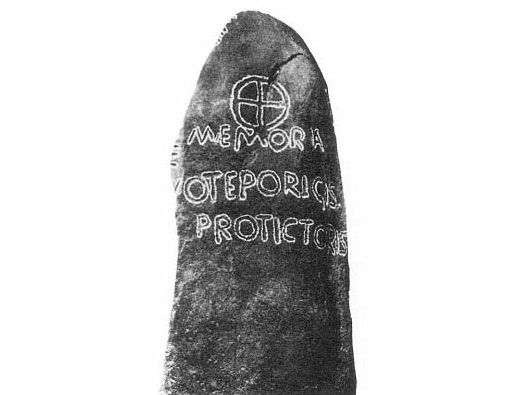 The Vortipor or Voteporix Stone, which is now held by the Carmarthenshire Antiquarian Society in Carmarthenshire, showing that this king had apparent links to Roman Britain, Dyfed, and also the Irish, almost certainly the Déisi Irish The Vortipor or Voteporix Stone, which is now held by the Carmarthenshire Antiquarian Society in Carmarthenshire, showing that this king had apparent links to Roman Britain, Dyfed, and also the Irish, almost certainly the Déisi Irish |
|
|
| fl c.550 |
Cyngar ap Gwrthefyr |
Son. The first name not to have a Latinised alternative. |
| fl c.570 |
Petr / Pedr ap Cyngar |
Son. |
| c.590 |
 The Bernician Angles successfully destroy the kingdom of 'The Peak' around this time, during a general expansion which also sees the fall of Dunoting around the same time. King Sawyl Penuchel is forced to flee to Wales. There is a story in the Life of St Cadoc which places him at Allt Cunedda near Kidwelly, within Dyfed's territory. However, the name of the location links it to Cunedda of Venedotia, suggesting that his campaigns to clear Wales of Irish raiders had extended much farther south than is otherwise known. The story about Sawyl in Wales has him and his warband stealing food from Llancarfan Abbey (hard times, clearly, for this dispossessed king). St Cadoc follows them and finds them sleeping under a tree. He cuts off their hair and flees to a bog. When Sawyl and his men follow the bog claims them. It is unclear if this is the same Sawyl, but the approximate dates for the saint coincide with his approximate dates. The Bernician Angles successfully destroy the kingdom of 'The Peak' around this time, during a general expansion which also sees the fall of Dunoting around the same time. King Sawyl Penuchel is forced to flee to Wales. There is a story in the Life of St Cadoc which places him at Allt Cunedda near Kidwelly, within Dyfed's territory. However, the name of the location links it to Cunedda of Venedotia, suggesting that his campaigns to clear Wales of Irish raiders had extended much farther south than is otherwise known. The story about Sawyl in Wales has him and his warband stealing food from Llancarfan Abbey (hard times, clearly, for this dispossessed king). St Cadoc follows them and finds them sleeping under a tree. He cuts off their hair and flees to a bog. When Sawyl and his men follow the bog claims them. It is unclear if this is the same Sawyl, but the approximate dates for the saint coincide with his approximate dates. 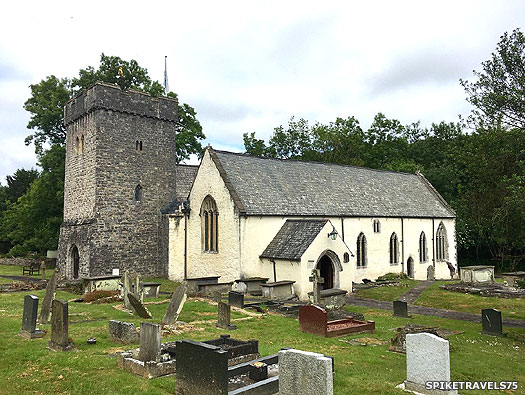 St Cadoc's Church is set in the village of Llancafarn in the Vale of Glamorgan in Wales, now famous thanks to a 2007 discovery of medieval religious illustrations beneath centuries of lime wash and paint, with these including 'St George and the Dragon', the 'Seven Deadly Sins', the 'Seven Virtues' and others, and with restoration work ongoing St Cadoc's Church is set in the village of Llancafarn in the Vale of Glamorgan in Wales, now famous thanks to a 2007 discovery of medieval religious illustrations beneath centuries of lime wash and paint, with these including 'St George and the Dragon', the 'Seven Deadly Sins', the 'Seven Virtues' and others, and with restoration work ongoing |
|
| c.595-c.615 |
Arthur map Petr |
Son. Named for Arthur Pendragon (High King). Born c.570-85. |
| fl c.625 |
Nowy Hen 'the Old' |
Son. King of Dyfed & Brycheiniog. |
| fl c.650 |
Cloten ap Nowy |
Son. King of Dyfed & Brycheiniog. Also known as Gwlyddien. |
| c.650 |
Ceindrych ferch Rhiwallon, princess of Brycheiniog, marries her distant cousin, Cloten, king of Dyfed, and for the space of three generations the two kingdoms are united. The name Cloten is an interesting echo of that of the earlier Clotrius ofDemetia. |
|
| fl c.670 |
Caten ap Cloten |
Son. King of Dyfed & Brycheiniog. |
| fl c.690 |
Cadwgan Tredylig ap Caten |
Son. King of Dyfed & Brycheiniog. |
| fl c.710 |
Regin / Rhain ap Cadwgan |
Son. King of Dyfed & Brycheiniog (this passed to brother). |
| 700 - 720 |
 During Rhain's rule, Dyfed is invaded by Seisyll, king of Ceredigion. He takes Ystrad Towy, and Rhain's dual kingdom is split in two. Both areas appear to have been known for a time as Rheinwg after their king, but now Rhain is forced to pass the sub-kingdom of Brycheiniog to a younger brother, Aust (or Awst). During Rhain's rule, Dyfed is invaded by Seisyll, king of Ceredigion. He takes Ystrad Towy, and Rhain's dual kingdom is split in two. Both areas appear to have been known for a time as Rheinwg after their king, but now Rhain is forced to pass the sub-kingdom of Brycheiniog to a younger brother, Aust (or Awst). |
|
| c.730 |
The precise status of the kingdom of Brycheiniog at this time is open to some question. Three of the sons of Rhain ap Cadwgn appear to divide Brycheiniog between themselves (probably following the death of Rhain himself). Some of their immediate descendants are referred to as 'king', but seem more likely to be lords of cantrefi (districts containing a hundred settlements) or commotes (one third or a half of a cantref). It may be the case that Naufedd Hen, Tewdos, and Elisse are in competition to see who comes out on top as the kingdom's ruler. |
|
| fl c.730 |
Teuder / Tewdos / Tewdr ap Regin |
Son. Seemingly also king of Brycheiniog (or part of it). |
| c.745 - 798 |
Meredydd ap Teuder |
Son. |
| 798 - 808 |
Rhein / Rhain ap Maredydd |
Son. |
| 808 - c.810 |
Triffyn ap Rhein |
Son. No heir. |
| c.810 - 811 |
Owain ap Meredydd |
Owain was the last male descendent of Aed Brosc. |
| 811 |
Although some sources suggest Hyfaidd ap Bledrig as the next ruler of Dyfed, a reign of about eighty-two years is clearly implausible. A ruling generation or more seems to have been lost, and it would not have included Hyfaidd's low-born father. Owain ap Meredydd had been the last male descendant of Aed Brosc, so who really succeeds him? Could the kingdom have splintered with several claimants each grabbing a share, to be slowly pulled back together by the end of the century? |
|
| ? - 893 |
Hyfaidd ap Bledrig / Bleddri |
Son of Tangwystyl ferch Owain and low-born Bledrig. |
| 893 - 904 |
Llywarch ap Hyfaidd |
Son. No heir. His dau, Elen (893-943), m Hywel Dda. |
| 896 |
Vikings have been wintering at Quatford (near Bridgnorth in Shropshire, part of western [Mercia](EnglandMercia.htm#Lords of Mercia)), but in the spring of this year they ravage the kingdoms of Brycheiniog,Gwent, and the Gwynllg region of Glywyssing. Asser records that Elisedd of Brycheiniog requests help from Alfred of Wessex, but another reason for this may also be due to pressure from Anarawd ap Rhodri, the powerful king of Gwynedd and Deheubarth who is keen on expanding his areas of control. Dyfed's Hyfaidd ap Bledrig may be another southern Welsh king who, during his lifetime, similarly appeals to Alfred for aid and support to ward off Anarawd. 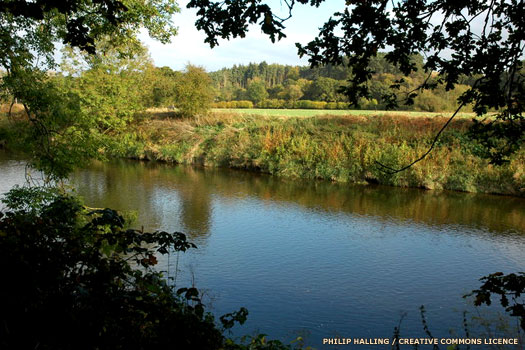 The Vikings found quarters at Quatford in Mercia, occupying a commanding position over the valley of the River Severn (just half a mile from the view shown here), and building a burgh which may have formed the basis of the later Norman castle The Vikings found quarters at Quatford in Mercia, occupying a commanding position over the valley of the River Severn (just half a mile from the view shown here), and building a burgh which may have formed the basis of the later Norman castle |
|
| 904 |
Rhodri ap Hyfaidd |
Brother. Beheaded. |
| 904 |
Cadell ap Rhodri of Seisyllwg and his son, Hywel Dda, conquer Dyfed. Hywel is granted control of the kingdom, a position which is an entirely legitimate claim in principle (if not in law) thanks to his marriage to Elen ferch Llywarch ap Hyfaidd. |
|
| 904 - 950 |
Hywel Dda (the Good) ap Cadell |
King of Deheubarth (Gwynedd, Powys, & Seisyllwg). |
| 916 |
 Hywel Dda is the son of Cadell of Seisyllwg. When he accedes to the throne of Deheubarth in 916 he is able to claim to rule a greater South Wales. In 942 he gains Gwynedd and rules a united Wales until his death. Once Gwynedd becomes detached from the remainder of the territory, former Dyfed provides the heartland along with Ceredigion (the former Seisyllwg) of the kingdom of Deheubarth. Hywel Dda is the son of Cadell of Seisyllwg. When he accedes to the throne of Deheubarth in 916 he is able to claim to rule a greater South Wales. In 942 he gains Gwynedd and rules a united Wales until his death. Once Gwynedd becomes detached from the remainder of the territory, former Dyfed provides the heartland along with Ceredigion (the former Seisyllwg) of the kingdom of Deheubarth. |
|
 |
|
|
 With the expulsion of Roman officials in AD 409 (see feature link), Britain again became independent of Rome and was not re-occupied. The fragmentation which had begun to emerge towards the end of the fourth century now appears to have accelerated, with minor princes, newly declared kings, and Roman-style magistrates all vying for power and influence while also facing the threat of extinction at the hands of the various barbarian tribes which were encroaching from all sides.
With the expulsion of Roman officials in AD 409 (see feature link), Britain again became independent of Rome and was not re-occupied. The fragmentation which had begun to emerge towards the end of the fourth century now appears to have accelerated, with minor princes, newly declared kings, and Roman-style magistrates all vying for power and influence while also facing the threat of extinction at the hands of the various barbarian tribes which were encroaching from all sides.  In the west, largely in what would become modern Wales, this process seems to have started earlier and taken place more quickly. Even by the start of the fifth century it is apparent that several territories had emerged here. The process seems to have been triggered by the reorganisations of Magnus Maximus in the late fourth century (see feature link), with what later tradition would claim as the creation of the 'kingdoms' of 'North Wales', 'South Wales', and 'Mid-South Wales'. That 'Kingdom of South Wales' as it was known in later traditional materials seems more often to have been known as Demetia in its early days, perhaps revealing a level of continuity from the pre-Roman tribe of the Demetae. Their territory was apparently given the Roman designation of civitas, this being the equivalent of a modern county, one which was based on the borders of each former tribal territory. The civitates (plural) could further be broken down into various pagi which were based around towns or major settlements. Initially, the Romano-British territory of Demetia maybe have been bordered by its North Wales counterpart, early Venedotia, and to the east both by the early Paganes territory, and by 'Mid-South Wales' in the form of Cernyw. It was apparently formed or first ruled by one of the many sons of Magnus Maximus - although perhaps they were 'sons' only in the sense that Maximus had created their positions and set them up in semi-independent domains. Demetia certainly bore the Romanised form of its name throughout the fourth and fifth centuries. Its early centre was at Castell Dwyran (in Carmarthenshire, roughly halfway between Carmarthen and Haverfordwest). The Demetian tribal centre at Maridunum (Moridunum) probably remained in use as the region's main trading point, with that Romanised name later becoming basis for modern 'Carmarthen'. Demetia's first 'king', Antonius, was charged with protecting the southern half of early Wales in much the same way as Cunedda was set up in Venedotia. Some of the territory he is claimed to have controlled was passed to younger sons, but which territory is not clear. The core of his holdings, however, was Demetia. Irish raiders were causing the British widespread problems throughout the fourth and fifth centuries. To combat this, a wandering sept of the Déisi tribe were probably settled in Demetia by Magnus Maximus to act as protectors of the coastline. Existing evidence confirms this by suggesting that the Roman authorities asked for the help of Aed Brosc of the Déisi in keeping Irish pirates away from Britain's western coast. When the last British ruler died without a male heir, the Déisi were on hand to fill the breach. By this time they had become semi-Romanised themselves (probably just as Romanised as their post-Roman British peers were by that stage, when Roman influence was gradually fading), and soon became indivisible from their western British subjects.
In the west, largely in what would become modern Wales, this process seems to have started earlier and taken place more quickly. Even by the start of the fifth century it is apparent that several territories had emerged here. The process seems to have been triggered by the reorganisations of Magnus Maximus in the late fourth century (see feature link), with what later tradition would claim as the creation of the 'kingdoms' of 'North Wales', 'South Wales', and 'Mid-South Wales'. That 'Kingdom of South Wales' as it was known in later traditional materials seems more often to have been known as Demetia in its early days, perhaps revealing a level of continuity from the pre-Roman tribe of the Demetae. Their territory was apparently given the Roman designation of civitas, this being the equivalent of a modern county, one which was based on the borders of each former tribal territory. The civitates (plural) could further be broken down into various pagi which were based around towns or major settlements. Initially, the Romano-British territory of Demetia maybe have been bordered by its North Wales counterpart, early Venedotia, and to the east both by the early Paganes territory, and by 'Mid-South Wales' in the form of Cernyw. It was apparently formed or first ruled by one of the many sons of Magnus Maximus - although perhaps they were 'sons' only in the sense that Maximus had created their positions and set them up in semi-independent domains. Demetia certainly bore the Romanised form of its name throughout the fourth and fifth centuries. Its early centre was at Castell Dwyran (in Carmarthenshire, roughly halfway between Carmarthen and Haverfordwest). The Demetian tribal centre at Maridunum (Moridunum) probably remained in use as the region's main trading point, with that Romanised name later becoming basis for modern 'Carmarthen'. Demetia's first 'king', Antonius, was charged with protecting the southern half of early Wales in much the same way as Cunedda was set up in Venedotia. Some of the territory he is claimed to have controlled was passed to younger sons, but which territory is not clear. The core of his holdings, however, was Demetia. Irish raiders were causing the British widespread problems throughout the fourth and fifth centuries. To combat this, a wandering sept of the Déisi tribe were probably settled in Demetia by Magnus Maximus to act as protectors of the coastline. Existing evidence confirms this by suggesting that the Roman authorities asked for the help of Aed Brosc of the Déisi in keeping Irish pirates away from Britain's western coast. When the last British ruler died without a male heir, the Déisi were on hand to fill the breach. By this time they had become semi-Romanised themselves (probably just as Romanised as their post-Roman British peers were by that stage, when Roman influence was gradually fading), and soon became indivisible from their western British subjects.
 Antonius Donatus Gregorius, son of Magnus Maximus (at least, according to later claims, and see feature link for more), is placed in command of the southern section of late [ Roman](../KingListsEurope/ItalyRomeEmpire.htm#Flavians Secundas) Britain's westernmost coast, in what is the equivalent to the later South Wales region. This is claimed as being part of the reorganisations of Magnus Maximus prior to his expedition into Gaul to claim the imperial title.
Antonius Donatus Gregorius, son of Magnus Maximus (at least, according to later claims, and see feature link for more), is placed in command of the southern section of late [ Roman](../KingListsEurope/ItalyRomeEmpire.htm#Flavians Secundas) Britain's westernmost coast, in what is the equivalent to the later South Wales region. This is claimed as being part of the reorganisations of Magnus Maximus prior to his expedition into Gaul to claim the imperial title.  The reverse of this coin which was issued by Magnus Maximus during his reign as co-emperor shows him standing, holding a laburnum and Victory on a globe
The reverse of this coin which was issued by Magnus Maximus during his reign as co-emperor shows him standing, holding a laburnum and Victory on a globe Carmarthen's Roman amphitheatre would still have been largely intact in this period, if perhaps rather scruffy, and the town walls remained standing (in part) as late as the time of Giraldus Cambrensis (twelfth century)
Carmarthen's Roman amphitheatre would still have been largely intact in this period, if perhaps rather scruffy, and the town walls remained standing (in part) as late as the time of Giraldus Cambrensis (twelfth century) He and his successors have been given Welsh names by later chroniclers (Anwn Dynod in his case, 'Anwn' from 'Antonius' and 'Dynod' from 'Donatus'), but it is much more likely that during their own lifetimes they bear Latinised names and conduct themselves as [ Romans](../KingListsEurope/ItalyRomeEmpire.htm#Flavians Secundas). Some elements of the life of Antonius may later be incorporated into the Arthurian stories (see feature link).
He and his successors have been given Welsh names by later chroniclers (Anwn Dynod in his case, 'Anwn' from 'Antonius' and 'Dynod' from 'Donatus'), but it is much more likely that during their own lifetimes they bear Latinised names and conduct themselves as [ Romans](../KingListsEurope/ItalyRomeEmpire.htm#Flavians Secundas). Some elements of the life of Antonius may later be incorporated into the Arthurian stories (see feature link). This map of Britain concentrates on British territories and kingdoms which were established during the fourth and fifth centuries AD, as the Saxons and Angles began their settlement of the east coast (click or tap on map to view full sized)
This map of Britain concentrates on British territories and kingdoms which were established during the fourth and fifth centuries AD, as the Saxons and Angles began their settlement of the east coast (click or tap on map to view full sized) Times were tough in the mid-fifth century, and Britain's resources were not what they had once been, what with barbarians at the door and withdrawal from the fading Roman empire, so Caer Gloui's amphitheatre had to be made defendable (Nemausus (Nimes) amphitheatre is shown here as an example)
Times were tough in the mid-fifth century, and Britain's resources were not what they had once been, what with barbarians at the door and withdrawal from the fading Roman empire, so Caer Gloui's amphitheatre had to be made defendable (Nemausus (Nimes) amphitheatre is shown here as an example) The expulsion of Roman officials in AD 409 (see feature link), meant that Post-Roman Britain struggled on without support from continental Europe. It faced plague, mercenary revolt, civil war, and a general break-down in trade, communications, and unity. Over the course of about three centuries the Britons gradually lost the entire west and centre of the island to Germanic invaders. In the west, largely in what would become modern Wales, the end of national unity seems to have started earlier and taken place more quickly. Several territories emerged here, with later tradition claiming the creation of the 'kingdoms' of 'North Wales', 'South Wales', and 'Mid-South Wales'. North Wales became Gwynedd, while South Wales became Dyfed, and these two states, along with Powys, formed the largest principalities in the surviving western British territories. They never in reality used the English term, 'kingdom'. The South Wales territory eventually became better known as Demetia - or it was known as this from the beginning. 'South Wales' was a later label for it anyway. It was a Romanised territory which offered a degree of continuation from the pre-Roman Demetae control of the region. The Déisi tribe of the County Waterford region in Ireland were apparently settled by the existing Roman authorities in the region of Demetia by AD 382, although this may well have been a defensive organisation of a group which had already infiltrated and settled the region. Their leader at the time, Aed Brosc, was one of his people's key figures. His grandfather, Eochaid Allmuir, had been forced to leave his homeland after a bid for independence failed. The descendants of Aed Brosc's eldest son, Urb, founded the kingdom of Brycheiniog between 420-450, while his younger son, Triffyn Farfog, married the heiress of the British Demetian rulers. Like most Irish royalty, Eochaid claimed descent from Beli Mawr, the Celtic sun god who was also claimed as a second century BC high king of pre-Roman Prydein, through his son, Miled. Another branch of the expelled Déisi became the Dál gCais clan of Thomond. The name Dyfed (also known as Dyfor) seems to have been the Déisi pronunciation of the older name of Demetia. The early Déisi settlers were very receptive to the benefits of the Roman way of life, and they gave their children Romano-British names. These were recorded by the early Welsh in Welsh format, and later rulers became completely Welsh in background as Roman influence faded. The Déisi rulers initially used the Roman title of 'protector' (protictoris) instead of the Latin 'magistrate' or princeps. This practice continued at least as far as Vortipor, whose memorial stone was discovered at Castell Dwyran.
The expulsion of Roman officials in AD 409 (see feature link), meant that Post-Roman Britain struggled on without support from continental Europe. It faced plague, mercenary revolt, civil war, and a general break-down in trade, communications, and unity. Over the course of about three centuries the Britons gradually lost the entire west and centre of the island to Germanic invaders. In the west, largely in what would become modern Wales, the end of national unity seems to have started earlier and taken place more quickly. Several territories emerged here, with later tradition claiming the creation of the 'kingdoms' of 'North Wales', 'South Wales', and 'Mid-South Wales'. North Wales became Gwynedd, while South Wales became Dyfed, and these two states, along with Powys, formed the largest principalities in the surviving western British territories. They never in reality used the English term, 'kingdom'. The South Wales territory eventually became better known as Demetia - or it was known as this from the beginning. 'South Wales' was a later label for it anyway. It was a Romanised territory which offered a degree of continuation from the pre-Roman Demetae control of the region. The Déisi tribe of the County Waterford region in Ireland were apparently settled by the existing Roman authorities in the region of Demetia by AD 382, although this may well have been a defensive organisation of a group which had already infiltrated and settled the region. Their leader at the time, Aed Brosc, was one of his people's key figures. His grandfather, Eochaid Allmuir, had been forced to leave his homeland after a bid for independence failed. The descendants of Aed Brosc's eldest son, Urb, founded the kingdom of Brycheiniog between 420-450, while his younger son, Triffyn Farfog, married the heiress of the British Demetian rulers. Like most Irish royalty, Eochaid claimed descent from Beli Mawr, the Celtic sun god who was also claimed as a second century BC high king of pre-Roman Prydein, through his son, Miled. Another branch of the expelled Déisi became the Dál gCais clan of Thomond. The name Dyfed (also known as Dyfor) seems to have been the Déisi pronunciation of the older name of Demetia. The early Déisi settlers were very receptive to the benefits of the Roman way of life, and they gave their children Romano-British names. These were recorded by the early Welsh in Welsh format, and later rulers became completely Welsh in background as Roman influence faded. The Déisi rulers initially used the Roman title of 'protector' (protictoris) instead of the Latin 'magistrate' or princeps. This practice continued at least as far as Vortipor, whose memorial stone was discovered at Castell Dwyran.
 This is a reconstruction of a typical Irish dwelling in the Bronze Age, at Cullyhanna in County Armagh, and it is probably safe to assume that the Irish in Demetia initially produced dwellings which were similar
This is a reconstruction of a typical Irish dwelling in the Bronze Age, at Cullyhanna in County Armagh, and it is probably safe to assume that the Irish in Demetia initially produced dwellings which were similar The coast of Pembrokeshire, part of the territory of the Demetae and the later kingdom of Dyfed, is a mixture of sandy beaches and daunting rocks (as at Marloes Sands, shown here), but there would have been many places for the Déisi to land and seize some territory
The coast of Pembrokeshire, part of the territory of the Demetae and the later kingdom of Dyfed, is a mixture of sandy beaches and daunting rocks (as at Marloes Sands, shown here), but there would have been many places for the Déisi to land and seize some territory They are not large in number but they do remain for a long time. Nearby Glastonbury is spoken of as 'Glastonbury of the Gaels' thanks to its shrines of St Patrick and St Brigit. The fort at Dunster features in the list of twenty-eight cities of Britain in Nennius' Historia Brittonum, appearing as Caer Draithou (see feature link), and is also mentioned in the Life of St Carannog (of Ceredigion).
They are not large in number but they do remain for a long time. Nearby Glastonbury is spoken of as 'Glastonbury of the Gaels' thanks to its shrines of St Patrick and St Brigit. The fort at Dunster features in the list of twenty-eight cities of Britain in Nennius' Historia Brittonum, appearing as Caer Draithou (see feature link), and is also mentioned in the Life of St Carannog (of Ceredigion). The landscape of Armorica - extremely hilly inland with a wonderful, long coastline - would have seemed very familiar to the Britons who began to settle here from the late fourth century onwards (Glomel in the modern Côtes-d'Armor département is shown here)
The landscape of Armorica - extremely hilly inland with a wonderful, long coastline - would have seemed very familiar to the Britons who began to settle here from the late fourth century onwards (Glomel in the modern Côtes-d'Armor département is shown here) The coming of Ælle in AD 477 and his apparently pre-established status as bretwalda spelled eventual defeat and death for the Britons of modern Sussex, and quite possibly led to the siege of Mons Badonicus around the end of the century
The coming of Ælle in AD 477 and his apparently pre-established status as bretwalda spelled eventual defeat and death for the Britons of modern Sussex, and quite possibly led to the siege of Mons Badonicus around the end of the century At the start of this period, the Angle and Saxon kingdoms on the east and south coasts were firmly established. Many of the rapidly-formed Romano-British territories in those areas had been swept away in the late fifth century (click or tap on map to view full sized)
At the start of this period, the Angle and Saxon kingdoms on the east and south coasts were firmly established. Many of the rapidly-formed Romano-British territories in those areas had been swept away in the late fifth century (click or tap on map to view full sized) Towards the end of his life, 'grey with age' and a widower, Vortipor is named by Gildas as the 'tyrant of the Demetae' (see feature link). He also leaves behind a memorial stone which confirms this epithet. Around 1880 the stone is incorporated into a stile at Castell Dwyran (by now St Teilo's Church). It is later moved to a field in front of Gwarmacwydd House, Llanfallteg, before being donated to the Carmarthenshire Antiquarian Society. Quite possibly originally associated with a Bronze Age barrow, and also positioned with reference to the Roman road to the west of Carmarthen, a simple ring cross tops the inscription. The use of 'memoria' and the layout of the cross and inscription suggest Christian contacts with continental Europe, or possibly North Africa. Vortipor is 'Demetarum tyranne Vortipori', which translates as 'Vortipor, tyrant of the Demetae', tyrant in the sense that he holds ultimate authority over the kingdom. The use of the Latin term 'protectoris' suggests a title which had originally referred to a member of the Roman imperial bodyguard, later a title for the nobility, and may be an hereditary title. It dates to the late fifth or early sixth century AD, precisely the time in which Vortipor is in power. There are remains of an Ogham inscription along the stone's top left edge, this being the early medieval script which is used to write down the Irish language.
Towards the end of his life, 'grey with age' and a widower, Vortipor is named by Gildas as the 'tyrant of the Demetae' (see feature link). He also leaves behind a memorial stone which confirms this epithet. Around 1880 the stone is incorporated into a stile at Castell Dwyran (by now St Teilo's Church). It is later moved to a field in front of Gwarmacwydd House, Llanfallteg, before being donated to the Carmarthenshire Antiquarian Society. Quite possibly originally associated with a Bronze Age barrow, and also positioned with reference to the Roman road to the west of Carmarthen, a simple ring cross tops the inscription. The use of 'memoria' and the layout of the cross and inscription suggest Christian contacts with continental Europe, or possibly North Africa. Vortipor is 'Demetarum tyranne Vortipori', which translates as 'Vortipor, tyrant of the Demetae', tyrant in the sense that he holds ultimate authority over the kingdom. The use of the Latin term 'protectoris' suggests a title which had originally referred to a member of the Roman imperial bodyguard, later a title for the nobility, and may be an hereditary title. It dates to the late fifth or early sixth century AD, precisely the time in which Vortipor is in power. There are remains of an Ogham inscription along the stone's top left edge, this being the early medieval script which is used to write down the Irish language.  The Vortipor or Voteporix Stone, which is now held by the Carmarthenshire Antiquarian Society in Carmarthenshire, showing that this king had apparent links to Roman Britain, Dyfed, and also the Irish, almost certainly the Déisi Irish
The Vortipor or Voteporix Stone, which is now held by the Carmarthenshire Antiquarian Society in Carmarthenshire, showing that this king had apparent links to Roman Britain, Dyfed, and also the Irish, almost certainly the Déisi Irish The Bernician Angles successfully destroy the kingdom of 'The Peak' around this time, during a general expansion which also sees the fall of Dunoting around the same time. King Sawyl Penuchel is forced to flee to Wales. There is a story in the Life of St Cadoc which places him at Allt Cunedda near Kidwelly, within Dyfed's territory. However, the name of the location links it to Cunedda of Venedotia, suggesting that his campaigns to clear Wales of Irish raiders had extended much farther south than is otherwise known. The story about Sawyl in Wales has him and his warband stealing food from Llancarfan Abbey (hard times, clearly, for this dispossessed king). St Cadoc follows them and finds them sleeping under a tree. He cuts off their hair and flees to a bog. When Sawyl and his men follow the bog claims them. It is unclear if this is the same Sawyl, but the approximate dates for the saint coincide with his approximate dates.
The Bernician Angles successfully destroy the kingdom of 'The Peak' around this time, during a general expansion which also sees the fall of Dunoting around the same time. King Sawyl Penuchel is forced to flee to Wales. There is a story in the Life of St Cadoc which places him at Allt Cunedda near Kidwelly, within Dyfed's territory. However, the name of the location links it to Cunedda of Venedotia, suggesting that his campaigns to clear Wales of Irish raiders had extended much farther south than is otherwise known. The story about Sawyl in Wales has him and his warband stealing food from Llancarfan Abbey (hard times, clearly, for this dispossessed king). St Cadoc follows them and finds them sleeping under a tree. He cuts off their hair and flees to a bog. When Sawyl and his men follow the bog claims them. It is unclear if this is the same Sawyl, but the approximate dates for the saint coincide with his approximate dates.  St Cadoc's Church is set in the village of Llancafarn in the Vale of Glamorgan in Wales, now famous thanks to a 2007 discovery of medieval religious illustrations beneath centuries of lime wash and paint, with these including 'St George and the Dragon', the 'Seven Deadly Sins', the 'Seven Virtues' and others, and with restoration work ongoing
St Cadoc's Church is set in the village of Llancafarn in the Vale of Glamorgan in Wales, now famous thanks to a 2007 discovery of medieval religious illustrations beneath centuries of lime wash and paint, with these including 'St George and the Dragon', the 'Seven Deadly Sins', the 'Seven Virtues' and others, and with restoration work ongoing During Rhain's rule, Dyfed is invaded by Seisyll, king of Ceredigion. He takes Ystrad Towy, and Rhain's dual kingdom is split in two. Both areas appear to have been known for a time as Rheinwg after their king, but now Rhain is forced to pass the sub-kingdom of Brycheiniog to a younger brother, Aust (or Awst).
During Rhain's rule, Dyfed is invaded by Seisyll, king of Ceredigion. He takes Ystrad Towy, and Rhain's dual kingdom is split in two. Both areas appear to have been known for a time as Rheinwg after their king, but now Rhain is forced to pass the sub-kingdom of Brycheiniog to a younger brother, Aust (or Awst). The Vikings found quarters at Quatford in Mercia, occupying a commanding position over the valley of the River Severn (just half a mile from the view shown here), and building a burgh which may have formed the basis of the later Norman castle
The Vikings found quarters at Quatford in Mercia, occupying a commanding position over the valley of the River Severn (just half a mile from the view shown here), and building a burgh which may have formed the basis of the later Norman castle Hywel Dda is the son of Cadell of Seisyllwg. When he accedes to the throne of Deheubarth in 916 he is able to claim to rule a greater South Wales. In 942 he gains Gwynedd and rules a united Wales until his death. Once Gwynedd becomes detached from the remainder of the territory, former Dyfed provides the heartland along with Ceredigion (the former Seisyllwg) of the kingdom of Deheubarth.
Hywel Dda is the son of Cadell of Seisyllwg. When he accedes to the throne of Deheubarth in 916 he is able to claim to rule a greater South Wales. In 942 he gains Gwynedd and rules a united Wales until his death. Once Gwynedd becomes detached from the remainder of the territory, former Dyfed provides the heartland along with Ceredigion (the former Seisyllwg) of the kingdom of Deheubarth.